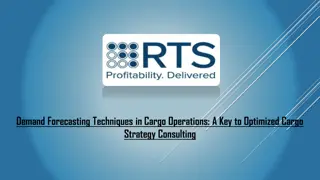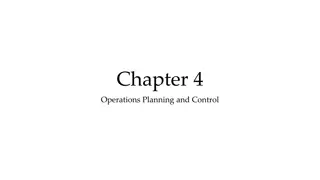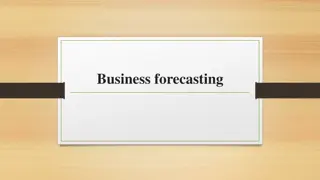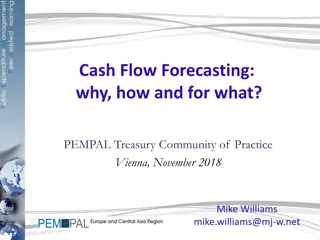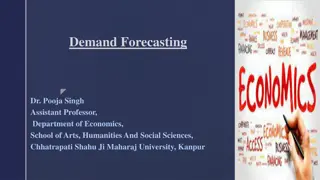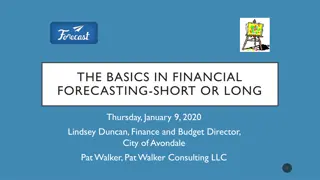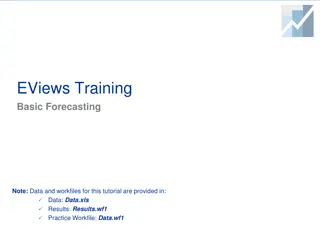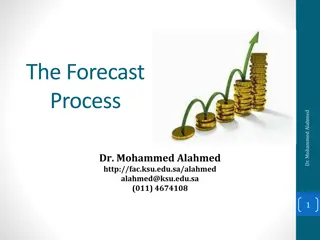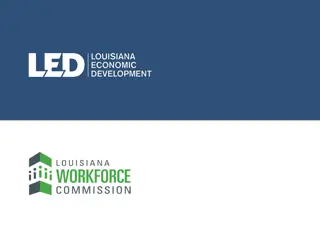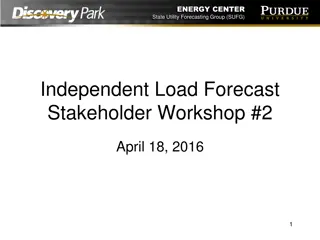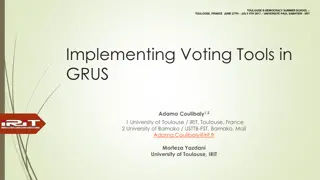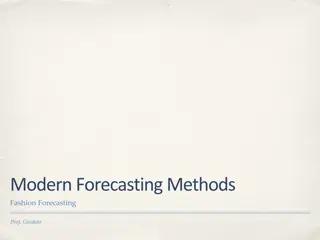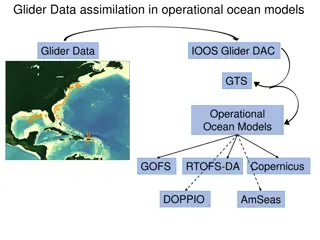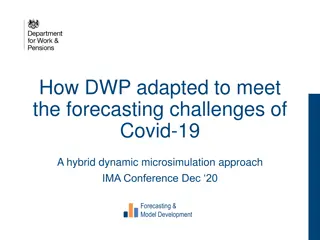Techniques and Importance of Forecasting for Strategic Decision-Making
Forecasting is a vital process for estimating future events that impact businesses. Deepali Hiremath, an Assistant Professor, emphasizes the significance of using statistical and non-statistical techniques to predict environmental changes. The steps involved include identifying relevant variables, collecting information, and selecting appropriate forecasting techniques. Critical variables, such as diesel prices for railways, must be considered to make accurate forecasts for effective strategic planning.
Download Presentation

Please find below an Image/Link to download the presentation.
The content on the website is provided AS IS for your information and personal use only. It may not be sold, licensed, or shared on other websites without obtaining consent from the author.If you encounter any issues during the download, it is possible that the publisher has removed the file from their server.
You are allowed to download the files provided on this website for personal or commercial use, subject to the condition that they are used lawfully. All files are the property of their respective owners.
The content on the website is provided AS IS for your information and personal use only. It may not be sold, licensed, or shared on other websites without obtaining consent from the author.
E N D
Presentation Transcript
Meaning and techniques Deepali Hiremath Assistant Professor
Forecasting is a way of estimating the future events that have a major impact on the enterprise. Environmental technique whereby predict the future organizational environment and hence make decisions today that will help the firm deal with the environment of tomorrow. forecasting is a managers characteristics attempt to of the Forecasting involves the use of statistical and non-statistical, or qualitative, techniques.
Estimating the intensity, nature and timing of the external forces performance of a firm, disrupt its plans, or force a change in its strategies. that may effect the
The steps are: 1. Identification of relevant environmental variables Before managers can begin to formulate an effective strategy, they must make a critical examination of the firm's environment. All environmental variables do not have the same relevance to all industries. Assessing the strategic situation is the first phase in determining the content of the proper strategies for a firm. This process begins with an assessment of the general environment of the firm, in terms of economic, technological, social, and political/legal influences
Eg., diesel price is a critical factor for railways using that energy source but not for electric trains. Omission of critical variables or inclusion of non-relevant variables could have misleading effects.
2. Collection of information Once the environmental variables are identified, the next step is to collect the information that is needed. It involves the identification of sources of information, determination of the types of information to be collected, selection of methods of data collection and collection of information.
3. Selection of forecasting technique The choice of depends on the nature of the forecast decision, the amount and accuracy of the available information, accuracy required, time available, importance of the forecast, the cost, etc., the forecasting technique
4. Monitoring Monitoring characteristics of the variables or their trends may undergo changes. Further new variables may emerge as critical or the relevance of certain variables may decline. It is therefore necessary to monitor changes. is very important as the
Strategic managers must not only understand the current state of the environment and their industry but also be able to forecast its future states. Moreover, once having implemented the environmental analysis process, management should continually evaluate and strive to improve it.
TYPES OF FORECASTING : Economic Forecast Social Forecast Political Forecast Technological Forecast 1. 2. 3. 4.
As a economic environment is a very critical determinant of business prospects, economic forecasts is very important. The Economic factors often considered include general economic conditions, GDP growth rate, per capita income, structural changes in GDP, Investment and output trends in different sectors and subsectors/industries, price trends, trade and BOP trends etc.
Social trends have significant implications for business strategy. It is, therefore , very essential to forecast the possible changes in the relevant social variables. Important factors include : Population growth/decline Ethnic composition Life Styles Social attitudes Income levels 1. 2. 3. 4. 5.
Political forecast has an important part in envisioning properly the future scenario of business. Relevant factors include : Changes in the relative power of Political party. Political alliances and political ideologies etc. Political forecasts also cover industrial policy, commercial policy, and Fiscal policy, International political developments are also important. 1. 2. 3.
Innovation and other technological developments can drastically alter the business environment. Technological forecasts, therefore, assumes great significance. It encompass not only technological innovations but also the pace and extent of diffusion and penetration of technologies and their implications.
Techniques of environmental forecasting quantitative qualitative Trend Econometric Brain storming Delphi method extrapolation/time series analysis Strategic issue analysis Judgment models Scenario development/ Multiple scenario
Quantitative techniques: It can be numberized i.e., under this technique numerical data is used. The following are the quantitative techniques : A. Econometric Technique : econometric is the statistical methods used by economists. It is a set of quantitative techniques that are useful in making economic decisions. It is the application of statistical and mathematical theories to economics for the purpose of testing hypotheses and forecasting future trends. For example : a real life application of econometrics would be to study the hypothesis that as a person s income increases , spending increases.
B. Trend Extrapolation / time series analysis: Time series models assume that the past is a introduction to the future and extrapolate(extending the application of a known information to an unknown situation) the historical data to the future. We can say future is viewed in the light of past under this technique. This is an empirical procedure in which certain historical trends (such as population growth, technological innovations, changes in incomes etc) are used to predict such variables as a firm s sales or market share. Because time series analysis projects historical trends into the future its validity depends on the similarity between past trends and future conditions.
Qualitative Technique: Under this technique numerical datas are not used. The following are the methods of qualitative technique 1. Brain Storming: Brain Storming is a creative method of generating ideas and forecasts. Under this method, a group of knowledgeable people are encouraged to generate ideas, discuss and to make forecasts on the basis of that. It is popular technique for technological forecasting. 2. Delphi Method: This is a forecasting procedure in which experts in the appropriate field of study are independently questioned about the probability of some event s occurrence. The responses of experts are compiled and a summary is sent to each expert. This process is repeated until consensus is arrived regarding a particular forecasted event.
3. Strategic Issue Analysis: it is the process of developing strategy for a business by researching the business and the environment in which it operates. A strategic issue is an issue or an unresolved question needing a decision or waiting for some clarifying future event. The developments, events and trends having the potential to impact an organisation are the strategic issues. It is strategic as it has a major impact on the course and direction of business.
4. Judgment models: This is a forecasting technique in which employees, customers, suppliers and/or trade associations serve as a source of qualitative information regarding future trends. For instance sales representatives may be asked to forecast sales growth in various product categories based on their interaction with customers. Survey instruments may be mailed to customers, suppliers or trade associations to obtain their judgments on specific trends.
5. Scenario development/ Multiple Scenario: Future events can t be predicted easily as our assumptions may go wrong, trends may change, events may take a different route altogether or some unexpected thing may change the whole scenario. To overcome these, a manager should formulate several alternative descriptions of future events and trends (called as multiple scenarios).






